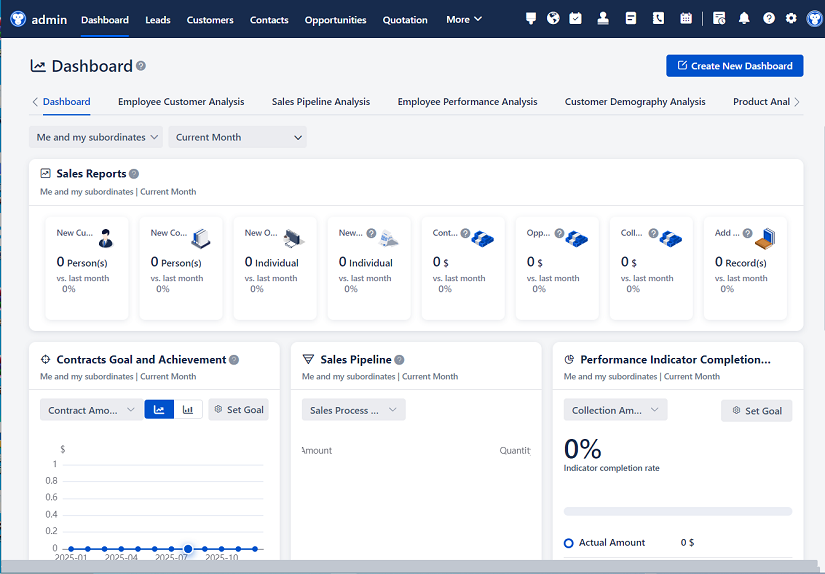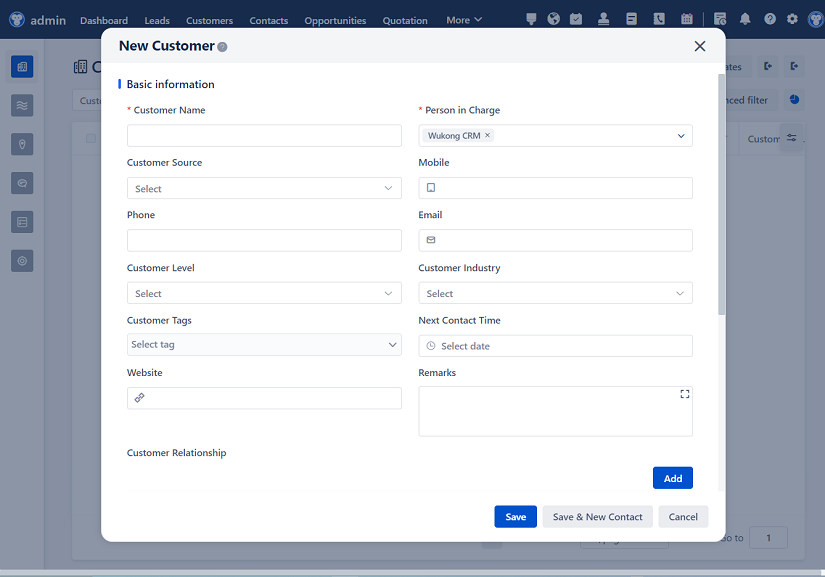
△Click on the top right corner to try Wukong CRM for free
You know, when I first started looking into how businesses manage their daily operations and customer relationships, I realized something pretty interesting—there’s this constant tug-of-war between two systems that are supposed to help companies run smoother: CRM and OA. At first glance, they might seem like they do similar things, right? But the more I dug into it, the clearer it became that they actually serve very different purposes, even though they often end up working side by side.
Let me break it down for you. CRM stands for Customer Relationship Management, and honestly, it’s all about the people your company interacts with—the customers. It tracks every little touchpoint: sales calls, emails, support tickets, even social media interactions. It’s like a digital diary of everything your business does with its clients. The goal? To build stronger relationships, close more deals, and keep customers happy over time.
Free use of CRM system: Free CRM
On the other hand, OA—Office Automation—is kind of the behind-the-scenes hero. It handles internal workflows: things like employee leave requests, document approvals, meeting schedules, and internal communications. Think of it as the nervous system of an organization, making sure everyone’s on the same page without having to chase each other down the hallway.
Now here’s where it gets really fascinating. Even though CRM and OA are designed for different audiences—one external, one internal—they’re not meant to live in separate worlds. In fact, when they work together, magic happens. But let’s be real, most companies don’t fully leverage that synergy. They treat them like two separate tools, almost like apps on your phone that never talk to each other. And that’s a missed opportunity.
I remember talking to a manager at a mid-sized tech firm who told me, “We use Salesforce for our sales team and DingTalk for internal comms. But no one connects them.” That stuck with me. Imagine if a sales rep closes a big deal in CRM—shouldn’t HR automatically get notified so they can start preparing onboarding? Or if a customer complaint comes in through CRM, shouldn’t the relevant department heads get an alert via OA so they can respond quickly?
That’s exactly what integration can do. When CRM and OA systems share data, decisions get faster, communication gets clearer, and employees spend less time switching between platforms. It’s not just about convenience—it’s about efficiency and reducing human error. No more manual data entry, no more lost emails in someone’s inbox.
But let’s not pretend it’s always smooth sailing. Integrating these systems can be tricky. For one, they often come from different vendors with different architectures. Getting them to “talk” requires APIs, middleware, or custom development—which means time, money, and IT expertise. And then there’s the cultural side: people resist change. Employees used to doing things one way might push back when new workflows are introduced.
Still, the benefits far outweigh the challenges. Take reporting, for example. If your CRM shows a spike in customer inquiries but your OA system reveals that the support team is understaffed or overwhelmed with internal tasks, leadership can make smarter decisions. Maybe they need to hire more staff, or redistribute workloads. Without both sets of data, you’re only seeing half the picture.
Another thing I’ve noticed is how CRM-OA synergy improves accountability. Let’s say a client requests a product demo. The CRM logs the request and assigns it to a salesperson. Through integration, the OA system can automatically create a task, set a deadline, and even schedule a calendar invite—all without anyone lifting a finger. Later, managers can check both systems to see if the task was completed and how long it took. That kind of transparency builds trust and keeps teams aligned.
And don’t even get me started on customer experience. When internal teams move faster because OA streamlines approvals and communication, customers feel the difference. Faster response times, quicker resolutions, personalized service—these aren’t just nice-to-haves; they’re expectations now. A seamless backend translates directly into a better frontend experience.
I also think about scalability. As companies grow, the complexity of managing both customer and internal operations increases exponentially. Startups might get by with spreadsheets and basic tools, but once you hit 50, 100, or 500 employees, you need structure. CRM and OA systems provide that structure—but only if they’re aligned. Otherwise, you end up with silos, duplicated efforts, and frustrated employees.

One company I read about—a logistics firm in Singapore—actually built a dashboard that pulls data from both their CRM and OA systems. Their sales team could see not just customer history, but also whether contracts were approved internally, if invoices were processed, and if delivery teams were scheduled. That holistic view helped them reduce delays by 30%. Pretty impressive, right?
But here’s the thing: technology alone isn’t the answer. You need strategy. Before integrating CRM and OA, ask yourself: What are our goals? Are we trying to improve response times? Reduce operational costs? Enhance collaboration? Once you know that, you can design integrations that actually serve your business needs instead of just ticking boxes.
Training is another big piece. I’ve seen cases where companies invest thousands in software but skimp on training. Then employees either ignore the system or misuse it. That’s like buying a sports car and never learning how to drive stick shift. So yeah, training matters. Make it ongoing, make it practical, and involve users early in the process.
Security is another concern. When you connect CRM and OA, you’re essentially linking customer data with internal employee data. That creates a larger attack surface. So proper access controls, encryption, and regular audits are non-negotiable. You don’t want a sales rep accidentally seeing HR salary records, or worse, a hacker exploiting weak integration points.
Despite all this, I still believe the future belongs to integrated systems. We’re already seeing platforms like Microsoft Dynamics 365 and Zoho One offering unified solutions that blend CRM, OA, ERP, and more. These aren’t perfect, but they’re moving in the right direction—toward a single source of truth for both customer and internal operations.
And let’s not forget AI and automation. Imagine a system that uses CRM data to predict which customers are at risk of churning, then automatically triggers an OA workflow to assign a retention specialist, draft a personalized email, and schedule a follow-up call. That’s not sci-fi—that’s possible today with the right setup.
Of course, not every business needs that level of sophistication. Small businesses might benefit more from simple integrations, like syncing CRM leads with OA task lists. The key is starting small, measuring results, and scaling up as needed.
One last thought: culture plays a huge role. If your company values transparency, collaboration, and continuous improvement, integrating CRM and OA will feel natural. But if departments operate in silos and information is hoarded, even the best technology won’t fix that. So while we talk about systems and data, we can’t ignore the human side.
In the end, CRM and OA aren’t rivals. They’re partners. One focuses outward, the other inward—but both exist to make organizations more effective. When they work together, the whole becomes greater than the sum of its parts. It’s like having a great offense and defense in basketball—you need both to win the game.
So if you’re sitting there thinking, “Should we integrate our CRM and OA?” my answer is yes—but do it thoughtfully. Understand your needs, plan carefully, involve your team, and keep iterating. Because in today’s fast-paced world, the companies that succeed aren’t just the ones with the best tools, but the ones that use them together in smart, meaningful ways.
FAQs (Frequently Asked Questions):
Q: What’s the main difference between CRM and OA systems?
A: Great question! CRM focuses on managing customer interactions and sales processes, while OA handles internal workflows like approvals, scheduling, and employee communication.
Q: Can CRM and OA systems really work together?
Absolutely! With proper integration—like using APIs or middleware—they can share data and automate cross-functional tasks, making the whole organization more efficient.
Q: Is integrating CRM and OA expensive?
It can be, depending on your systems and needs. But many modern platforms offer pre-built connectors, and the long-term gains in productivity often justify the cost.

Q: Do small businesses need both CRM and OA?
Not necessarily, but they can still benefit. Even small teams can use basic CRM and OA tools to stay organized and scale more smoothly.
Q: What happens if CRM and OA aren’t integrated?
You risk inefficiency, data silos, delayed responses, and miscommunication. Teams end up working in isolation, which hurts both employee experience and customer satisfaction.
Q: How do I start integrating CRM and OA in my company?
Start by identifying key workflows that span both systems—like lead-to-onboarding or customer support escalation. Then pilot a small integration, gather feedback, and expand gradually.
Q: Are there security risks in connecting CRM and OA?
Yes, especially around data access and privacy. Always implement role-based permissions, encrypt sensitive data, and monitor system activity regularly.

Q: Which industries benefit most from CRM-OA synergy?
Service-based industries like finance, healthcare, education, and tech tend to gain the most, since they rely heavily on both customer engagement and internal coordination.
Q: Can AI enhance CRM and OA integration?
Definitely. AI can analyze CRM data to predict customer behavior and trigger automated OA workflows—like assigning high-priority leads or flagging overdue internal tasks.
Q: What’s the biggest mistake companies make with CRM and OA?
Probably treating them as isolated tools. The real value comes from connecting them strategically to support broader business goals—not just installing software for the sake of it.

Related links:
Free trial of CRM
Understand CRM software

△Click on the top right corner to try Wukong CRM for free